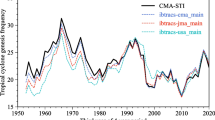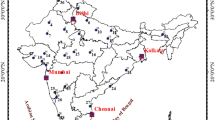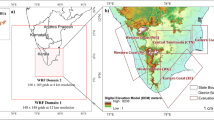Abstract
This study conducted 24- to 72-h multi-model ensemble forecasts to explore the tracks and intensities (central mean sea level pressure) of tropical cyclones (TCs). Forecast data for the northwestern Pacific basin in 2010 and 2011 were selected from the China Meteorological Administration, European Centre for Medium-Range Weather Forecasts (ECMWF), Japan Meteorological Agency, and National Centers for Environmental Prediction datasets of the Observing System Research and Predictability Experiment Interactive Grand Global Ensemble project. The Kalman Filter was employed to conduct the TC forecasts, along with the ensemble mean and super-ensemble for comparison. The following results were obtained: (1) The statistical–dynamic Kalman Filter, in which recent observations are given more importance and model weighting coefficients are adjusted over time, produced quite different results from that of the super-ensemble. (2) The Kalman Filter reduced the TC mean absolute track forecast error by approximately 50, 80 and 100 km in the 24-, 48- and 72-h forecasts, respectively, compared with the best individual model (ECMWF). Also, the intensity forecasts were improved by the Kalman Filter to some extent in terms of average intensity deviation (AID) and correlation coefficients with reanalysis intensity data. Overall, the Kalman Filter technique performed better compared to multi-models, the ensemble mean, and the super-ensemble in 3-day forecasts. The implication of this study is that this technique appears to be a very promising statistical–dynamic method for multi-model ensemble forecasts of TCs.






Similar content being viewed by others
References
DeMaria M, Sampson CR, Knaff JA, Musgrave KD (2014) Is tropical cyclone intensity guidance improving? Bull Am Meteorol Soc 95:387–398
Evensen G (1997) Advanced data assimilation for strongly nonlinear dynamics. Mon Weather Rev 125:1342–1354
Evensen G, van Leeuwen PJ (2000) An ensemble Kalman smoother for nonlinear dynamics. Mon Weather Rev 128:1852–1867
Feng JM et al (2011) Comparison of four ensemble methods combining regional climate simulations over Asia. Meteorol Atmos Phy 111:41–53
Franklin JL (2012) National Hurricane Center forecast verification report. http://www.nhc.noaa.gov/verification/pdfs/Verification_2012.pdf
Goerss JS (2000) Tropical cyclone track forecasts using an ensemble of dynamical models. Mon Weather Rev 128:1187–1193
Goh SL, Mandic DP (2007) An augmented extended Kalman filter algorithm for complex-valued recurrent neural networks. Neural Comput 19:1039–1055
Grijn GVD (2002) Tropical cyclone forecasting at ECMWF: new products and validation. ECMWF Tech, Mem 386
Krishnamurti TN et al (1999) Improved weather and seasonal climate forecasts from multimodel superensemble. Science 285:1548–1550
Krishnamurti TN, Kishtawal CM, Shin DW, Williford CE (2000) Improving tropical precipitation forecasts from a multianalysis superensemble. J Clim 13:4217–4227
Kumar T, Krishnamurti TN, Fiorino M, Nagata M (2003) Multimodel superensemble forecasting of tropical cyclones in the Pacific. Mon Weather Rev 131:574–583
Lenartz F, Mourre B, Barth A, Beckers JM, Vandenbulcke L, Rixen M (2010) Enhanced ocean temperature forecast skills through 3-D super-ensemble multi-model fusion. Geophy Res Lett 37:5
Leslie LM, Fraedrich K (1990) Reduction of tropical cyclone position errors using an optimal combination of independent forecasts. Weather Forecast 5:158–161
Libonati R, Trigo I, DaCamara CC (2008) Correction of 2 m-temperature forecasts using Kalman Filtering technique. Atmos Res 87:183–197
Marchok TP (2002) How the NCEP tropical cyclone tracker works. AMS conference on hurricanes and tropical meteorology
McCollor D, Stull R (2008) Hydrometeorological accuracy enhancement via postprocessing of numerical weather forecasts in complex terrain. Weather Forecast 23:131–144
Qi LB, Yu H, Chen PY (2014) Selective ensemble-mean technique for tropical cyclone track forecast by using ensemble prediction systems. Q J R Meteorol Soc 140:805–813
Rixen M et al (2009) Improved ocean prediction skill and reduced uncertainty in the coastal region from multi-model super-ensembles. J Marine Syst 78:S282–S289
Shin DW (2001) Short- to medium-range superensemble precipitation forecasts using satellite products. Florida State University, p 35
Shin DW, Krishnamurti TN (2003) Short- to medium-range superensemble precipitation forecasts using satellite products: 1 deterministic forecasting. J Geophys Res Atmos 108:18
Tien TT, Thanh C, Van HT, Chanh KQ (2012) Two-dimensional retrieval of typhoon tracks from an ensemble of multimodel outputs. Weather Forecast 27:451–461
Vandenbulcke L et al (2009) Super-ensemble techniques: application to surface drift prediction. Prog Oceanogr 82:149–167
Williford CE, Krishnamurti TN, Torres RC, Cocke S, Christidis Z, Kumar TSV (2003) Real-time multimodel superensemble forecasts of Atlantic tropical systems of 1999. Mon Weather Rev 131:1878–1894
WMO (2008a) Guidelines on communicating forecast uncertainty. http://www.wmo.int/pages/prog/amp/pwsp/documents/TD-1422.pdf
Yamaguchi M (2013) Tropical cyclone predictability. http://www.ecmwf.int/newsevents/training/meteorological_presentations/2013/PR2013/Yamaguchi/Yamaguchi.pdf
Zhang L, Zhi XF (2015) Multimodel consensus forecasting of low temperature and icy weather over central and southern China in early 2008. J Trop Meteorol 121(1):67–75
Zhi XF, Zhang L, Bai Y (2011) Application of the multi-model ensemble forecast in the QPF. In: Information Science and Technology (ICIST), 2011 international conference on, IEEE, pp 657–660
Zhi XF, Qi HX, Bai YQ, Lin CZ (2012) A comparison of three kinds of multimodel ensemble forecast techniques based on the TIGGE data. Acta Meteorologica Sinica 26:41–51
Acknowledgments
This work was funded by the National Basic Research Program “973” of China (2012CB955200), the China Meteorological Administration Special Public Welfare Research Fund (GYHY200906009) and the Priority Academic Program Development (PAPD) of Jiangsu Higher Education Institutions. We are grateful to Mr. Zaheer Ahmed Babar for his valuable suggestions. Also, we would like to thank two anonymous reviewers for their useful comments.
Author information
Authors and Affiliations
Corresponding author
Additional information
Responsible Editor: X.-Y. Huang.
Rights and permissions
About this article
Cite this article
He, C., Zhi, X., You, Q. et al. Multi-model ensemble forecasts of tropical cyclones in 2010 and 2011 based on the Kalman Filter method. Meteorol Atmos Phys 127, 467–479 (2015). https://doi.org/10.1007/s00703-015-0377-1
Received:
Accepted:
Published:
Issue Date:
DOI: https://doi.org/10.1007/s00703-015-0377-1




